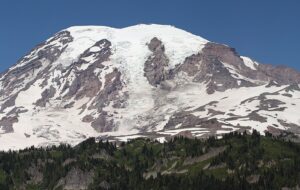“I’ve been doing this for 30 years,” said an anonymous climber, after kicking off a wet slide that sent him for a big ride and almost wiped us off the face [of] the Abruzzi today.
The quote is from Himalayan guide Adrian Ballinger, currently on K2 with Ecuador’s Carla Pérez on a No-O2 climb. Ballinger and many others were on their way to Camps 1 and 2 on the “normal” Abruzzi Spur route, taking advantage of good weather before the next storm hits. They were following the trail of a rope-fixing team, which had opened the route to Camp 2 earlier this week.
Ballinger is a seasoned high-altitude climber and guide. His ironical comment depicts a cause for concern on K2. The problem is two-fold: an excess of climbers and too many of them lacking basic mountaineering skills to deal with unforeseen problems.
Yesterday, Carlos Garranzo (at home after climbing Lhotse) posted a picture of climbers “training” with crampons and Jumars on some snow bumps near Base Camp. “Better come to K2 with the training done at home,” he commented.
A Catalan mountain guide who attempted Gasherbrum IV last year, told ExplorersWeb that several climbers currently in Pakistan picked their 8,000m goals depending on whether they might need an ice-axe or not. “They avoid Gasherbrum II, because they had heard that they would need to use the ice-axe on the summit pyramid, but not on K2, whose only downside seemed to be that it was more expensive,” he said aghast.
In fact, the scene at K2 Base Camp is like a painting in progress that, as it gets more detailed, increasingly resembles the recent Everest mess:
“We at Seven Summit Treks just completed the Puja Ceremony at K2 BC; tomorrow all members will start their first acclimatization, as rope has been fixed till C2,” reads SST’s report. “Sherpa will climb to C2 on 6th July, scheduling 7th and 8th for C3 opening.” Except for the letters “K2”, you’d imagine that the comment was sent two months ago from Everest Base Camp.

School-like group photo of a Seven Summits Treks team, after a puja ceremony. The Nepal-based outfitter is now organizing expeditions in Pakistan as well.
The SST team is huge, and the Sherpas leading clients are actual Sherpas from Nepal, not local Baltis, who simply fix the route and carry loads up the Baltoro. Climbers have commented on the scarcity of porters because of the sheer size of the expeditions and their increasing requirements. As Karakorum Expeditions cheerfully noted, “There are over 160 climbers on K2 this summer!”
Meanwhile, a far-from-cheerful Alan Arnette wondered, “Queuing at House Chimney, the Bottleneck and the Traverse occurs when there are less than 30 people on the Hill. What will happen with five times that?”
The answer is not hard to see. Instead of Everest’s huge valley of silence, climbers at Camps 1, 2, and 3 on K2 will encounter tiny platforms on rocky outcrops and steep ledges.
Higher up, further challenges await. Consider that the use of supplementary O2 has become standard even on “lower” 8,000’ers and is now the norm on K2. Queues may lead climbers to run out of gas and find themselves exhausted well above 8,000m. And, let’s remember, there is no easy route on K2.
Given this situation on the Abruzzi, Lina Quesada of Spain has decided to take the less crowded Cesen route. Unfortunately, the Cesen actually joins the Abruzzi at the Shoulder, so that the most dangerous features of K2’s upper sections — the steep, narrow Bottleneck and the infamous hanging serac above — are shared.

The Abruzzi Spur and Cesen Routes on K2’s southeast side. Photo: Cranfield University
No amount of gear or bottled O2 can decrease the objective dangers on the so-called “Savage Mountain”: its quickly evolving storms, its avalanche danger, the high risk of getting lost above Camp 3 and especially, falling blocks of ice from the great serac.
The worst tragedy on K2 occurred in 2008, when part of that serac collapsed. It not only killed those right under it and triggered an avalanche, but it took away the fixed ropes, which stranded climbers on the slopes above. It left them with the choice of trying to descend without ropes in the dark, or waiting for help in the serac’s danger zone. Indeed, another collapse happened the following day.
Eleven people died back then, and critics were fierce about too many climbers on the route, which delayed progress, and the overuse of personal Sherpas or guides on a peak that had previously been only for highly experienced, self-sufficient climbers.
As Adrian Ballinger went on to say about yesterday’s avalanche:
We all make mistakes in the big mountains. We made one today, being on the face too late in the day when it was way too hot. Our stoke to get high for the first time and see the route clouded our decision-making and put us in a position to be under a slide in the first place. But when we fuck up like this, we acknowledge it, talk about it, and share it. We try to learn from screwing up and getting lucky. The team that triggered the slide, when we went to check they were ok, came up with, “I’ve been doing this for 30 years.” Sweet…I’m sure the mountain cares.
Related story:
Will There Also Be Traffic Jams on K2?






